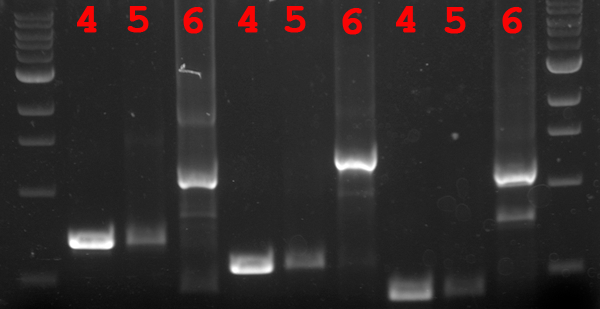Sauer:Stitching Genes by PCR
Contributed by Smoore 03-10-07.
Introduction
This method allows you to "stitch" genes or coding sequences together when there are no convenient restriction sites at the junction point. It is especially useful when the target gene is flanked by other genes that can't be disrupted. The technique is by no means new, but this should keep people from asking me how to do it.
Protocol
Refer to this figure:
- Step 1:
Scan your sequence and find restriction sites anywhere to the left and right of the gene (the left one can be in your gene). Make sure they are unique and they are not contained in the fragment you want to append to your gene. In the figure, they are marked "A" and "B".
- Step 2:
Design 4 primers. "A forward" primes toward your gene and anneals to the left of (or on) the restriction site "A"; "B reverse" primes back toward your gene and anneals past (or on) restriction site "B"; "stitch forward" anneals to amplify your appendage and has a tail that matches (anneals to) the left side of the fusion point (green in this case); 'stitch reverse" reverse primes your appendage and has a tail that encodes the region just to the right of the fusion point. The dashed lines show where the primers match.
- Step 3:
PCR your appendage. If it is small (like a His tag), you can just have the two primers form a cassette when annealed. In this case, the appendage is a bit bigger, so PCR is used to make the product from another template that contains the appendage. Only do about 20 cycles, you don't need a lot and this will reduce errors.
- Step 4:
Set up a PCR with a microliter of the "appendage" PCR reaction in step 3 and a microliter of a miniprep containing your plasmid with your gene of interest. Use primers "stitch forward" and "B reverse". You will end up with the product shown. I usually gel purify this product for the next step. Again, you don't need a lot, use about 20 cycles.
- Step 5:
Set up a primer extention reaction with the gel purified product from step 4 and your plasmid. Use about half of the gel-purified product from step 4. Set the extension time long enough so the polymerase will extend to the left restriction stite "A". Both strands of the PCR product will act as primers and you will end up with a heterogeneous population of single-stranded products. The products that you need are the "bottom strand" extensions that primed back toward your site "A". About 20 cycles will do.
AFTER THIS STEP, add the restriction enzyme Dpn I to the PCR reaction and incubate for 1-2 hours at 37 degrees. You are eliminating the added plasmid. This is important.
- Step 6:
Without cleaning the reaction from step 5, set up a new PCR that contains half of the PCR/degradation reaction from step 5. This is your template. Remember, you haven't cleaned the reaction, so you only need to add PCR buffer for 50% of the volume. Use the normal primer and dNTP concentrations and add fresh polymerase. Use primers "A forward" and "B reverse". 20 cycles (you have a lot of template). Remember to increase the extention time so the polymerase can read the whole desired product.
- Step 7:
Clean the reaction, digest with restriction enzymes "A" and "B". Also cut your plasmid with them. Ligate the fragment and you're done.
Example gel:
An example of 3 different stitching reactions at steps 4, 5, and 6. I usually only check these by gel. Notice after step 5, the product seems to be greatly reduced, but there is a hetergeneous population of fragments that don't resolve as sharp bands that are larger than the starting primers (PCR product of step 4). The final PCR amplifies the desired product so it can be purified.
Notes
You can switch the first stitching reaction so that the left side is added first. I set mine up so the shorter of the two arms is added first. The primer extension that adds the longer arm is reading off of the plasmid and will have very few errors. In doing this, you keep the larger amplifications to short segments and reduce your chanced of getting a mutation in the final product. Keeping the cycles reduced also helps because you don't deplete the dNTPs and starve your enzyme.
Since your going through the trouble of building the fusion, incorporate some unique, user-friendly restriction sites in your stitched product so modifying the gene in the future is a lot easier.

